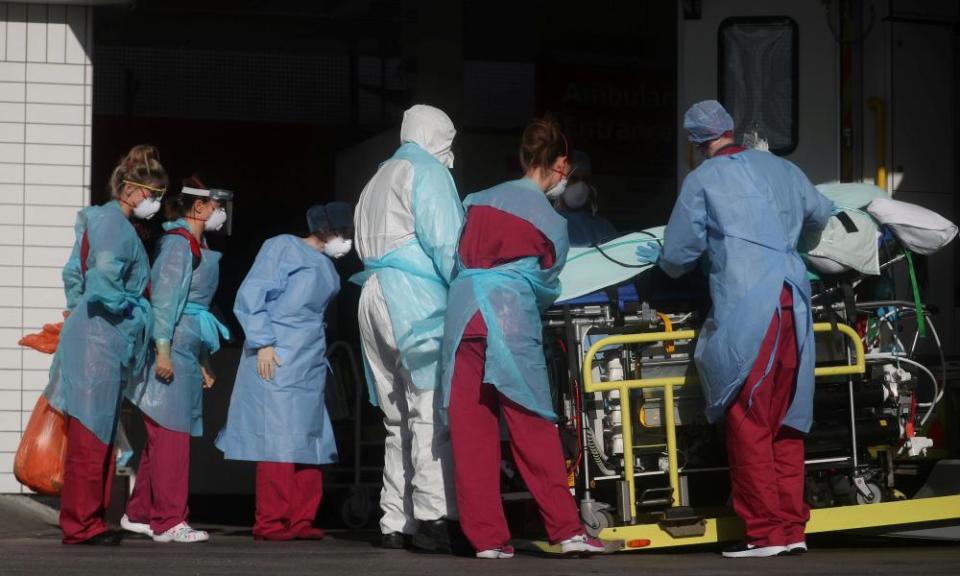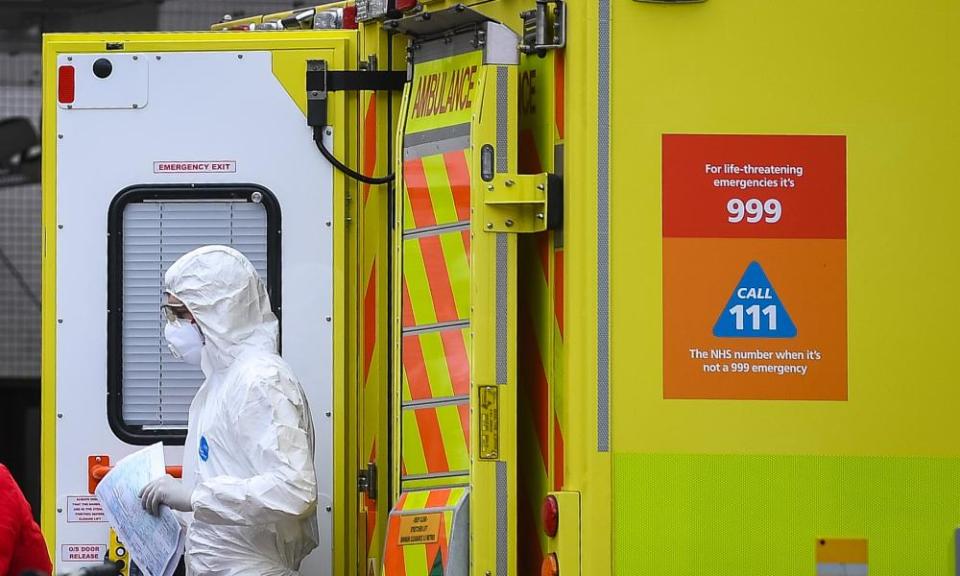View from NHS staff in frontline of battle against coronavirus

Patients that need hospital treatment for coronavirus may need a team of NHS staff to help them through.
Jessica Murray talks to the people who are key to such treatment – from first responders to intensive care consultants to physiotherapists.
Mark, 36, a paramedic
We’re informed by the control centre whether the patient is query Covid-19, but we’re wearing protective equipment - mask and protective eyewear - for pretty much all jobs now. We’re going into people’s houses and it’s an enclosed space so we’re not able to social distance.
Because people can’t visit Covid patients in hospital, we facilitate the conversation so people can say their goodbyes, without being too explicit about it. We then advise them to take a phone with them if they’re able to, make sure they’ve got a charger and if they don’t know how to video call, we might quickly teach them how to use it before we set off.
We then take them to A&E but through a different door for Covid patients - although we’re finding the Covid side is busier than the normal side.
Then we’ll deep clean the ambulance. We have to clean inside of our cab, around the steering wheel and all the stuff that we would touch, and it’s difficult because there’s a lot of equipment and crevices in an ambulance.
What is Covid-19?
It is caused by a member of the coronavirus family that has never been encountered before. Like other coronaviruses, it has come from animals.
What are the symptoms this coronavirus causes?
The virus can cause pneumonia-like symptoms. Those who have fallen ill are reported to suffer coughs, fever and breathing difficulties.
In the UK, the National Heath Service has defined the symptoms as:
a high temperature - you feel hot to touch on your chest or back
a new continuous cough - this means you've started coughing repeatedly
Should I go to the doctor if I have a cough?
Medical advice varies around the world - with many countries imposing travel bans and lockdowns to try and prevent the spread of the virus. In many place people are being told to stay at home rather than visit a doctor of hospital in person. Check with your local authorities.
In the UK, NHS advice is that anyone with symptoms should stay at home for at least 7 days. If you live with other people, they should stay at home for at least 14 days, to avoid spreading the infection outside the home.
How many people have been affected?
China’s national health commission confirmed human-to-human transmission in January. As of 31 March, more than 780,000 people have been infected in more than 170 countries, according to the Johns Hopkins University Center for Systems Science and Engineering.
There have been over 37,800 deaths globally. Just over 3,200 of those deaths have occurred in mainland China. Italy has been worst affected, with over 11,500 fatalities, and there have been over 7,700 deaths in Spain. The US now has more confirmed cases than any other country - more than 164,000. Many of those who have died had underlying health conditions, which the coronavirus complicated.
More than 166,000 people are recorded as having recovered from the coronavirus.
Astrid, 28, healthcare assistant
We have the most patient contact out of any healthcare workers. [We] help the nurses with the really basic but essential tasks, such as washing and changing patients, helping them go to the toilet and helping them eat.
With the current coronavirus crisis, that role has expanded because we are so short-staffed - our ward is down 60% of staff at the moment. We’re doing the Covid testing swabs and transferring positive patients around the hospital. I work on a trauma and orthopaedic ward, which is now on lockdown because we have so many confirmed cases.
With both suspected and confirmed patients, we are only wearing surgical masks, sleeveless, plastic aprons and gloves, so there’s no eye protection and no arm protection. Today I worked a 13-hour shift with a patient who is confirmed positive, and I’m still going in with basically nothing.
We also get a lot of the stress and abuse from patients who are scared and confused and don’t know what’s going on, because we’re the people they see most.
Tom, 31, radiographer
We’re not classed as frontline workers even though we are very much on the frontline because every Covid-19 patient is coming to us. Medical staff don’t know what they’re dealing with unless the patient comes through radiology.
You don’t see Covid-19 in the lungs, so I’m using the chest X-rays and CT scans to look for patches, mainly on the edges of the lungs, which suggest infectious changes. We’re looking for pneumonia and fluid.
For ICU patients who are on a ventilator and not looking well, we’re likely to be down there at least daily, if not a couple of times a day, for chest X-rays. We have portable X-ray machines on wheels so we can go direct to the patients on the wards, but the CT scanner is a huge machine so they have to come to us for that one, which poses quite a logistical nightmare.
We’re needed in A&E, across the wards and, in the ICU we’re used all the time. We’ve also got a postmortem CT scanner so we’re anticipating Covid patients coming to us that way as well.

Chris, 35, intensive care consultant
I care for some of the sickest patients in the hospital who have a chance of getting over their illness. If someone is in hospital with Covid-19 and their oxygen levels continue to deteriorate, they will often be transferred to intensive care as they might need a ventilator.
If that happens, a team of three or four of us will drift them off to sleep and put a breathing tube through their mouth into the airway. In some cases, we also turn them on to their front, for about 16-18 hours a day, because some Covid-19 studies suggest this can help with oxygenation. That takes at least five people.
We wear full PPE to go in and see patients, meaning a mask and either a visor and goggles or a full respirator helmet, as well as a gown, apron and three pairs of gloves. But we try to spend as little time in with them as possible to minimise our exposure.
default
I lead the ward rounds, and manage the whole patient - not just the lungs and the right amount of oxygen, but also the heart, the kidneys, and all the other organ systems. Covid-19 can affect the whole body, and many organs may need supporting.
We’re seeing many patients stay on a ventilator for about seven to 10 days. After that, the hope is the oxygen levels have returned close enough to normal that patients can breath sufficiently on their own.
It’s quite an invasive process coming to intensive care. You have quite a lot done to you. But that’s because you need it.
Carol*, 57, critical care nurse
In critical care there’s a nurse by the bedside 24/7 - although obviously not the same nurse or we would burn out pretty fast. Other medical staff, like the consultants, physiotherapists and nutritionists, tend to go from patient to patient, so they rely an awful lot on the bedside nurses’ insight.
If someone is having breathing difficulties, we can reposition them, administer medicines, use oxygen masks, or maintain their ventilator. With breathing, you need to be pretty damn quick at reacting. If five or 10 minutes go by, bad stuff can happen.
We also do the things for the patients that they cannot do themselves. So we’ll wipe their eyes, lubricate them, make sure their eyelids are shut, we’ll brush their teeth, suction out any buildup of saliva and apply lip balm. We’ll use bedpans, we’ll put in catheters and monitor those, we’ll wash the patients, change their bedding and we’ll regularly reposition them. We’ll also talk to them because we’re never quite sure what level of consciousness they have.
When the bedside nurse is in full protective equipment, they can’t just nip away to pick up the medicine or a new set of linen. So you have someone who stays in the amber zone away from the patients, who can fetch stuff.
Another big part of my job is supporting family and friends, giving them updates and providing emotional support. In this current situation, we’re also exploring using FaceTime for patients to talk with their loved ones.
Ema, 38, respiratory physiotherapist
We help identify patients who need extra help breathing, and then help to maintain their chest and keep it clear of secretions. We are the people who are actually asking Covid patients to cough.
As they’re breathing out on the ventilator, we give their chest a really good shake with our hands. It just helps to clear the phlegm, because they can’t cough as they’re paralysed and sedated. We do the cough for them, using our hands on their chest and tummy. It’s a lot of very hands on treatment. We’re then working with the nurses and medics to ultimately wean them off the ventilator.
We also do physical rehabilitation. It might be just sitting on the edge of the bed, but for somebody who’s been tubed on intensive care, that is like running a marathon.
Covid-19 patients are probably going to be in intensive care for a little bit longer than we’re used to, so I think then we will also play a big role in rehabilitation. I think there’s going to be a lot of post traumatic stress, and probably a lot of breathing pattern disorder.
*Name has been changed

